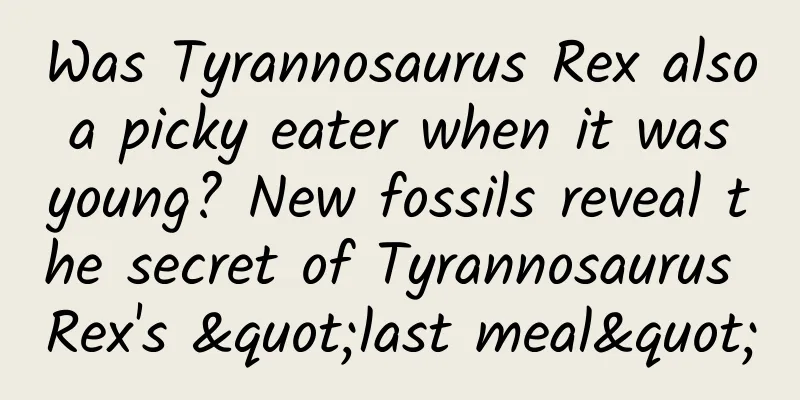Was Tyrannosaurus Rex also a picky eater when it was young? New fossils reveal the secret of Tyrannosaurus Rex's "last meal"

|
Adult Tyrannosaurus rex was a formidable predator with powerful jaws and extremely penetrating teeth that could kill giant herbivores larger than itself. However, paleontologists recently discovered that the young Tyrannosaurus rex ate different prey, and the prey was much smaller. The relevant research was published in Science Advances on December 8. About 77 million years ago, in what is now Alberta, Canada, Gorgonosaurus (a type of Tyrannosaurus Rex) was the "king of the land." They were as heavy as a white rhino and as long as 30 feet from teeth to the tip of the tail. Source: Tuchong Creative Based on fossilized feces and gnawed bones, scientists know that adult Tyrannosaurus rex used their bone-crushing teeth to eat large herbivorous dinosaurs the size of African elephants, such as Triceratops and Hadrosaurs. However, what juvenile Tyrannosaurus rex ate has been a matter of debate, as their skulls and teeth were not as sturdy as those of adults. In the new study, dinosaur paleontologist Darla Zelenitsky of the University of Calgary in Canada and her colleagues describe a new fossil of a juvenile Gorgosaur found in Dinosaur Provincial Park in Alberta, Canada, one of the richest deposits of dinosaur fossils in the world. The young dinosaur was about 5 to 7 years old, about 15 feet long and weighed about 1,000 pounds, about the weight of a large domestic pig and about 10 times the weight of its parents. Juvenile dinosaur fossils are very rare in the region because rivers that run through the region's floodplains tend to break up the smaller, more fragile bones of young dinosaurs after they die, Zelenitsky said. Even more rare, the juvenile skeleton contained the remains of two smaller dinosaurs that the T. rex preyed on. The two smaller dinosaurs were less than a year old and weighed about the same as a modern turkey. "This is the first direct evidence that a T. rex juvenile was eating smaller, younger dinosaurs," Zelenitsky said. She added that an adult T. rex probably wouldn't have eaten the small animals because they wouldn't have provided many calories. The fossils show that the young Tyrannosaurus Rex also seemed to be very picky when it came to eating, as it only ate the two hind legs of each prey, which were the fattiest parts. "This is the last meal of T. rex, preserved in a fossil!" said Steve Brusatte, a paleontologist at the University of Edinburgh in the United Kingdom and one of the study authors. "This is direct evidence of what T. rex ate, not just speculation." "It's a surprising finding, and while it's based on just one individual, which isn't ideal for ecological inferences, the interpretation is quite plausible," said Felisa Smith, a paleoecologist at the University of New Mexico, who was not involved in the study. She also thinks that based on the similar tooth wear between juvenile and adult Tyrannosaurus, adults may have fed larger prey to their young. |
>>: How many minutes should you boil eggs to make them tasty? This experiment will tell you!
Recommend
Who "killed" Luo Yonghao?
A friend said he wanted to buy a ticket to attend...
Xiaohongshu’s strategy for creating hot products and case analysis!
This article mainly analyzes the brand’s marketin...
If you continue playing with your phone like this, you might actually go blind!
Every night before going to bed, I turn off the l...
What are the requirements for opening a Baidu bidding account? What are the advantages of Baidu search promotion?
Baidu bidding promotion is a kind of online promo...
Zhuang Wen's Go video tutorial Baidu Cloud download
Teacher Zhuang Wen's Go video tutorial 40 les...
Pilots are not allowed to have scars, but why can injured pilots continue to fly?
As we all know, the medical examination for pilot...
Major changes in advertising and marketing strategies over the past century!
On the day JWT was merged with digital marketing ...
I have tried all the methods taught in the book, but why are all the promotions I do useless?
I've read so many books and attended so many ...
In the era of scene social networking, you need more than instant messaging
In the book "The Coming Era of Scenarios&quo...
Newbie Science: 79 Common Terms in Marketing
You must know some basic terms about marketing or...
Promoting activation and retention: analysis of user growth system design
1. What is the user growth system? The evolution ...
Electric Technology Car News: Easily under 4 seconds, these must-see cars at this year's Geneva Motor Show
On March 7, Beijing time, the Geneva Internationa...
Developed and built by the Chinese Academy of Sciences, it is the first in Asia! Experiments will begin soon →
Not long ago, Asia's first electromagnetic ca...
Kuaishou’s tips on how to create hits!
As a social method for the younger generation, &q...
Why do plant leaves change color?
When autumn comes, the leaves in the parks and on...









